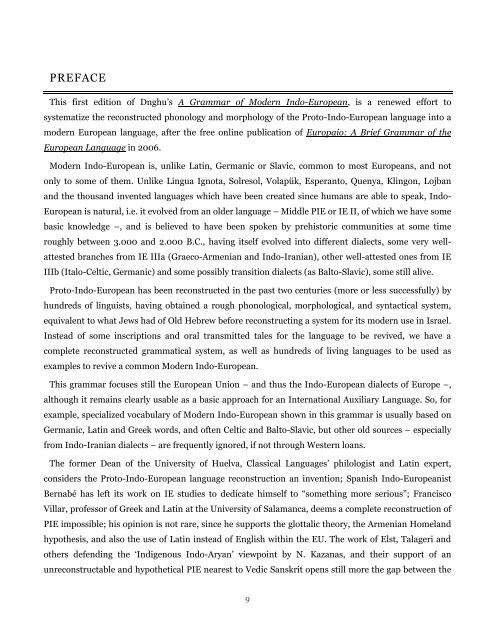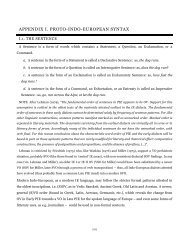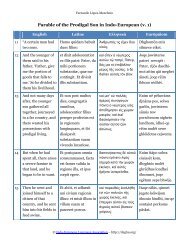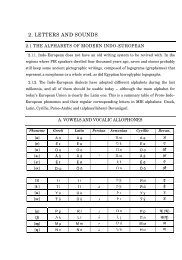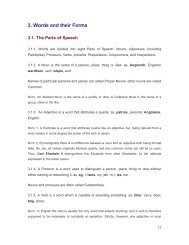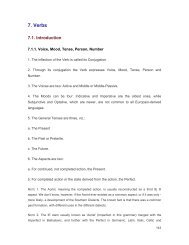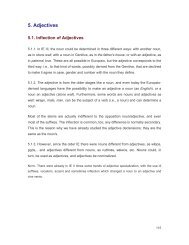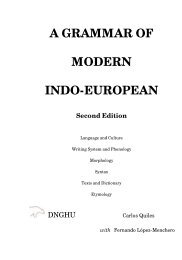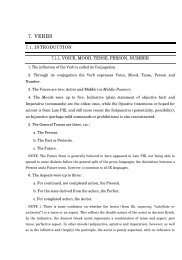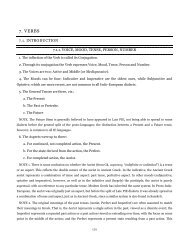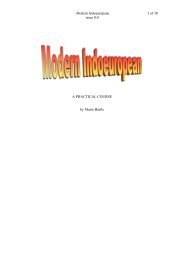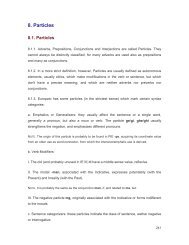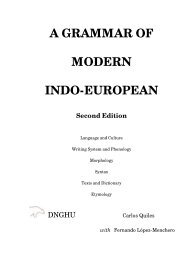Create successful ePaper yourself
Turn your PDF publications into a flip-book with our unique Google optimized e-Paper software.
PREFACE<br />
This first edition of Dnghu‘s A Grammar of Modern Indo-European, is a renewed effort to<br />
systematize the reconstructed phonology and morphology of the Proto-Indo-European language into a<br />
modern European language, after the free online publication of Europaio: A Brief Grammar of the<br />
European Language in 2006.<br />
Modern Indo-European is, unlike Latin, Germanic or Slavic, common to most Europeans, and not<br />
only to some of them. Unlike Lingua Ignota, Solresol, Volapük, Esperanto, Quenya, Klingon, Lojban<br />
and the thousand invented languages which have been created since humans are able to speak, Indo-<br />
European is natural, i.e. it evolved from an older language – Middle PIE or IE II, of which we have some<br />
basic knowledge –, and is believed to have been spoken by prehistoric communities at some time<br />
roughly between 3.000 and 2.000 B.C., having itself evolved into different dialects, some very well-<br />
attested branches from IE IIIa (Graeco-Armenian and Indo-Iranian), other well-attested ones from IE<br />
IIIb (Italo-Celtic, Germanic) and some possibly transition dialects (as Balto-Slavic), some still alive.<br />
Proto-Indo-European has been reconstructed in the past two centuries (more or less successfully) by<br />
hundreds of linguists, having obtained a rough phonological, morphological, and syntactical system,<br />
equivalent to what Jews had of Old Hebrew before reconstructing a system for its modern use in Israel.<br />
Instead of some inscriptions and oral transmitted tales for the language to be revived, we have a<br />
complete reconstructed grammatical system, as well as hundreds of living languages to be used as<br />
examples to revive a common Modern Indo-European.<br />
This grammar focuses still the European Union – and thus the Indo-European dialects of Europe –,<br />
although it remains clearly usable as a basic approach for an International Auxiliary Language. So, for<br />
example, specialized vocabulary of Modern Indo-European shown in this grammar is usually based on<br />
Germanic, Latin and Greek words, and often Celtic and Balto-Slavic, but other old sources – especially<br />
from Indo-Iranian dialects – are frequently ignored, if not through Western loans.<br />
The former Dean of the University of Huelva, Classical Languages‘ philologist and Latin expert,<br />
considers the Proto-Indo-European language reconstruction an invention; Spanish Indo-Europeanist<br />
Bernabé has left its work on IE studies to dedicate himself to ―something more serious‖; Francisco<br />
Villar, professor of Greek and Latin at the University of Salamanca, deems a complete reconstruction of<br />
PIE impossible; his opinion is not rare, since he supports the glottalic theory, the Armenian Homeland<br />
hypothesis, and also the use of Latin instead of English within the EU. The work of Elst, Talageri and<br />
others defending the ‗Indigenous Indo-Aryan‘ viewpoint by N. Kazanas, and their support of an<br />
unreconstructable and hypothetical PIE nearest to Vedic Sanskrit opens still more the gap between the<br />
9
Indo-European Revival Association – http://dnghu.org/<br />
A <strong>GRAMMAR</strong> <strong>OF</strong> <strong>MODERN</strong> <strong>INDO</strong>-<strong>EUROPEAN</strong><br />
mainstream reconstruction and minority views supported by nationalist positions. Also, among<br />
convinced Indo-Europeanists, there seems to be no possible consensus between the different ‗schools‘<br />
as to whether PIE distinguished between ŏ and ă (as Gk., Lat. or Cel.) or if those vowels were all initial<br />
ă, as in the other attested dialects (Villar), or if the Preterites were only one tense (as Latin<br />
praeteritum) with different formations, or if there were actually an Aorist and a Perfect.<br />
Furthermore, José Antonio Pascual, a member of the Royal Spanish Academy (RAE), considers that<br />
―it is not necessary to be a great sociologist to know that 500 million people won‘t agree to adopt<br />
Modern Indo-European in the EU‖ (Spa. journal El Mundo, 8 th April 2007). Of course not, as they won‘t<br />
agree on any possible question – not even on using English, which we use in fact –, and still the<br />
national and EU‘s Institutions work, adopting decisions by majorities, not awaiting consensus for any<br />
question. And it was probably not necessary to be a great sociologist a hundred years ago to see e.g. that<br />
the revival of Hebrew under a modern language system (an ―invention‖ then) was a utopia, and that<br />
Esperanto, the ‗easy‘ and ‗neutral‘ IAL, was going to succeed by their first World Congress in 1905.<br />
Such learned opinions are only that, opinions, just as if Hebrew and Semitic experts had been<br />
questioned a hundred years ago about a possible revival of Biblical Hebrew in a hypothetic new Israel.<br />
Whether MIE‘s success is more or less probable (and why) is not really important for our current<br />
work, but hypothesis dealt with by sociology, anthropology, political science, economics and even<br />
psychology, not to talk about chance. Whether the different existing social movements, such as Pan-<br />
Latinism, Pan-Americanism, Pan-Sanskritism, Pan-Arabism, Pan-Iranism, Pan-Slavism, Pan-<br />
Hispanism, Francophonie, Anglospherism, Atlanticism, and the hundred different pan-nationalist<br />
positions held by different sectors of societies – as well as the different groups supporting anti-<br />
globalization, anti-neoliberalism, anti-capitalism, anti-communism, anti-occidentalism, etc. – will<br />
accept or reject this project remains unclear.<br />
What we do know now is that the idea of reviving Proto-Indo-European as a modern language for<br />
Europe and international organizations is not madness, that it is not something new, that it doesn‘t<br />
mean a revolution – as the use of Spanglish, Syndarin or Interlingua –nor an involution – as<br />
regionalism, nationalism, or the come back to French, German or Latin predominance –, but merely<br />
one of the many different ways in which the European Union linguistic policy could evolve, and maybe<br />
one way to unite different peoples from different cultures, languages and religions (from the Americas<br />
to East Asia) for the sake of stable means of communication. Just that tiny possibility is enough for us<br />
to ―lose‖ some years trying to give our best making the (Proto-)Indo-European language as usable and<br />
as known as possible.
PREFACE TO THE FIRST EDITION<br />
11<br />
Preface<br />
According to Dutch sociologist Abram de Swaan, every language in the world fits into one of four<br />
categories according to the ways it enters into (what he calls) the global language system.<br />
• Central: About a hundred languages in the world belong here, widely used and comprising about<br />
95% of humankind.<br />
• Supercentral: Each of these serves to connect speakers of central languages. There are only<br />
twelve supercentral languages, and they are Arabic, Chinese, English, French, German,<br />
Hindi, Japanese, Malay, Portuguese, Russian, Spanish and Swahili.<br />
• Hypercentral: The lone hypercentral language at present is English. It not only connects central<br />
languages (which is why it is on the previous level) but serves to connect supercentral languages as<br />
well. Both Spanish and Russian are supercentral languages used by speakers of many languages,<br />
but when a Spaniard and a Russian want to communicate, they will usually do it in English.<br />
• Peripheral: All the thousands of other languages on the globe occupy a peripheral position<br />
because they are hardly or not at all used to connect any other languages. In other words, they are<br />
mostly not perceived as useful in a multilingual situation and therefore not worth anyone's effort<br />
to learn.<br />
De Swaan points out that the admission of new member states to the European Union brings with it<br />
the addition of more languages, making the polyglot identity of the EU ever more unwieldy and<br />
expensive. On the other hand, it is clearly politically impossible to settle on a single language for all the<br />
EU's institutions. It has proved easier for the EU to agree on a common currency than a common<br />
language.<br />
Of the EU's current languages, at least 14 are what we might call a ‗robust‘ language, whose speakers<br />
are hardly likely to surrender its rights. Five of them (English, French, German, Portuguese and<br />
Spanish) are supercentral languages that are already widely used in international communication, and<br />
the rest are all central.<br />
In the ongoing activity of the EU's institutions, there are inevitably shortcuts taken - English, French<br />
and German are widely used as 'working languages' for informal discussions. But at the formal level all<br />
the EU's official languages (i.e. the language of each member state) are declared equal.<br />
Using all these languages is very expensive and highly inefficient. There are now 23 official languages:<br />
Bulgarian, Czech, Danish, Dutch, English, Estonian, Finnish, French, German, Greek,<br />
Hungarian, Irish Gaelic, Italian, Latvian, Lithuanian, Maltese, Polish, Portuguese,<br />
Romanian, Slovak, Slovene, Spanish and Swedish, and three semiofficial (?): Catalan, Basque<br />
and Galician. This means that all official documents must be translated into all the members'
Indo-European Revival Association – http://dnghu.org/<br />
A <strong>GRAMMAR</strong> <strong>OF</strong> <strong>MODERN</strong> <strong>INDO</strong>-<strong>EUROPEAN</strong><br />
recognized languages, and representatives of each member state have a right to expect a speech in their<br />
language to be interpreted. And each member state has the right to hear ongoing proceedings<br />
interpreted into its own language.<br />
Since each of the twenty one languages needs to be interpreted/translated into all the rest of the<br />
twenty, 23 x 22 (minus one, because a language doesn't need to be translated into itself) comes to a total<br />
of 506 combinations (not taking on accound the ‗semiofficial‟ languages). So interpreters/translators<br />
have to be found for ALL combinations.<br />
In the old Common Market days the costs of using the official languages Dutch, English, French, and<br />
German could be borne, and interpreters and translators could be readily found. But as each new<br />
member is admitted, the costs and practical difficulties are rapidly becoming intolerably burdensome.<br />
The crucial point here is that each time a new language is added, the total number of combinations isn't additive<br />
but multiplies: 506 + one language is not 507 but 552, i.e. 24 x 23, since every language has to be<br />
translated/interpreted into all the others (except itself).<br />
It is not hard to see that the celebration of linguistic diversity in the EU only lightly disguises the<br />
logistical nightmare that is developing. The EU is now preparing for more languages to come:<br />
Romanian and Bulgarian have been recently added, with the incorporation of these two countries to<br />
the EU; Albanian, Macedonian, Serbian, Bosnian and Croatian (the three formerly known as<br />
Serbo-Croatian, but further differentiated after the Yugoslavian wars) if they are admitted to the EU as<br />
expected; and many other regional languages, following the example of Irish Gaelic, and the three semi-<br />
official Spanish languages: Alsatian, Breton, Corsican, Welsh, Luxemburgish and Sami are<br />
likely candidates to follow, as well as Scottish Gaelic, Occitan, Low Saxon, Venetian,<br />
Piedmontese, Ligurian, Emilian, Sardinian, Neapolitan, Sicilian, Asturian, Aragonese,<br />
Frisian, Kashubian, Romany, Rusin, and many others, depending on the political pressure their<br />
speakers and cultural communities can put on EU institutions. It will probably not be long before<br />
Turkish, and with it Kurdish (and possibly Armenian, Aramaic and Georgian too), or maybe<br />
Ukrainian, Russian and Belarusian, are other official languages, not to talk about the eternal<br />
candidates‘ languages, Norwegian (in at least two of its language systems, Bokmål and Nynorsk),<br />
Icelandic, Romansh, Monegasque (Monaco) and Emilian-Romagnolo (San Marino), and this<br />
could bring the number of EU languages over 40. The number of possible combinations are at best<br />
above 1000, which doesn't seem within the reach of any organization, no matter how well-meaning.<br />
Many EU administrators feel that to a great extent this diversity can be canceled out by ever-<br />
increasing reliance on the computer translation that is already in heavy use. It is certainly true that if we<br />
couldn't count on computers to do a lot of the translation ‗heavy lifting‘, even the most idealistic<br />
administrator would never even dream of saddling an organization with an enterprise that would
13<br />
Preface<br />
quickly absorb a major part of its finances and energy. But no machine has yet been invented or<br />
probably ever will be that is able to produce a translation without, at the very least, a final editing by a<br />
human translator or interpreter.<br />
The rapidly increasing profusion of languages in the EU is quickly becoming intolerably clumsy and<br />
prohibitively expensive. And this doesn't even count the additional expense caused by printing in the<br />
Greek alphabet and soon in the Cyrillic (Bulgarian and Serbian). Everyone agrees that all languages<br />
must have their 'place in the sun' and their diversity celebrated. But common sense suggests that the EU<br />
is going to be forced to settle on a very small number of working languages, perhaps only one, and the<br />
linguistic future of the EU has become the subject of intense debate.<br />
Only in public numbers, the EU official translation/interpretation costs amount to more than 1.230<br />
M€, and it comes to more than 13% of today's administrative expenditure of the EU institutions. There<br />
are also indirect costs of linguistic programmes aimed at promoting the learning of three or more<br />
languages since the Year of Languages (2001), which also means hundreds of millions of Euros, which<br />
haven't been counted in the EU's budget as linguistic expenditure, but are usually included in budget<br />
sections such as Cohesion or Citizenship. It is hard to imagine the huge amount of money (real or<br />
potential) lost by EU citizens and companies each day because of communication problems, not only<br />
because they can't speak a third party's language, but because they won't speak it, even if they can.<br />
Preserving the strict equality is the EU's lifeblood, and it is a very disturbing thought that the strongest<br />
candidate for a one-language EU is the one with an established dominance in the world, English,<br />
which is actually only spoken by a minority within Europe. Latin and Artificial languages (as Esperanto,<br />
Ido or Interlingua) have been proposed as alternatives, but neither the first, because it is only related to<br />
romance languages, nor the second, because they are (too) artificial (invented by one person or a small<br />
group at best), solve the linguistic theoretical problems, not to talk about the practical ones.<br />
The Indo-European language that we present in this work, on the contrary, faces not only the<br />
addressed theoretical problems - mainly related to cultural heritage and sociopolitical proud - but<br />
brings also a practical solution for the European Union, without which there can be no real integration.<br />
European nations are not prepared to give up some of their powers to a greater political entity, unless<br />
they don't have to give up some fundamental rights. Among them, the linguistic ones have proven<br />
harder to deal with than it initially expected, as they are raise very strong national or regional feelings.<br />
Indo-European is already the grandmother of the majority of Europeans. The first language of more<br />
than 97% of EU citizens is Indo-European, and the rest can generally speak at least one of them as<br />
second language. Adopting Indo-European as the main official language for the EU will not mean giving<br />
up linguistic rights, but enhancing them, as every other official language will have then the same status
Indo-European Revival Association – http://dnghu.org/<br />
A <strong>GRAMMAR</strong> <strong>OF</strong> <strong>MODERN</strong> <strong>INDO</strong>-<strong>EUROPEAN</strong><br />
under their common ancestor; it won't mean losing the own culture for the sake of unity, but recovering<br />
it altogether for the same purpose; and, above all, it will not mean choosing a lingua franca to<br />
communicate with foreigners within an international organization, but accepting a National Language<br />
to communicate with other nationals within the same country.<br />
NOTE. The above information is mainly copied (literally, adjusted or modified) from two of Mr. William Z.<br />
Shetter Language Miniatures, which can be found in his website:<br />
http://home.bluemarble.net/~langmin/miniatures/Qvalue.htm<br />
http://home.bluemarble.net/~langmin/miniatures/eulangs.htm<br />
o EU official expenditure numbers can be consulted here:<br />
http://europa.eu.int/rapid/pressReleasesAction.do?reference=MEMO/05/10&type=HTML&aged=0&la<br />
nguage=EN&guiLanguage=en<br />
http://europa.eu.int/comm/budget/library/publications/budget_in_fig/dep_eu_budg_2007_en.pdf<br />
o Official information about EU languages can be found at:<br />
http://europa.eu.int/comm/education/policies/lang/languages/index_en.html<br />
http://europa.eu.int/comm/education/policies/lang/languages/langmin/euromosaic/index_en.html
WHAT'S NEW IN THIS EDITION<br />
15<br />
Preface<br />
This is A Grammar of Modern Indo-European, First Edition, with Modern Indo-European Language<br />
Grammatical system in Version 3, still in βeta phase – i.e., still adjusting some major linguistic<br />
questions, and lots of minor mistakes, thanks to the contributions of experts and readers. The timetable<br />
of the next grammatical and institutional changes can be followed in the website of the Indo-European<br />
Language Association at www.dnghu.org.<br />
―Modern Indo-European‖ 3.x (June 2007) follows the revised edition of V. 2.x, which began in March<br />
2007, changing some features of ―Europaio‖/―Sindhueuropaiom‖ 1.x (2005-2006), in some cases<br />
coming back to features of Indo-European 0.x (2004-2005), especially:<br />
1. The artificial distinction in ―Europaiom‖ and ―Sindhueuropaiom‖ systems (each based on different<br />
dialectal features) brings more headaches than advantages to our Proto-Indo-European revival project;<br />
from now on, only a unified ―Modern Indo-European‖ is promoted.<br />
2. Unlike the first simplified grammar, this one goes deep into the roots of the specific Indo-European<br />
words and forms chosen for the modern language. Instead of just showing the final output, expecting<br />
readers to accept the supposed research behind the selections, we let them explore the details of our<br />
choices – and sometimes the specifics of the linguistic reconstruction –, thus sacrificing simplicity for<br />
the sake of thorough approach to modern IE vocabulary.<br />
3. The old Latin-only alphabet has been expanded to include Greek and Cyrillic writing systems, as<br />
well as a stub of possible Armenian, Arabo-Persian and Devanagari (abugida) systems. The objective is<br />
not to define them completely (as with the Latin alphabet), but merely to show other possible writing<br />
systems for Modern Indo-European.<br />
4. The traditional phonetic distinction of palatovelars was reintroduced for a more accurate phonetic<br />
reconstruction of Late PIE, because of the opposition found (especially among Balto-Slavic experts)<br />
against our simplified writing system. Whether satemization was a dialectal and phonological trend<br />
restricted to some phonetic environments (PIE *k- before some sounds, as with Latin c- before -e and -<br />
i), seemed to us not so important as the fact that more people feel comfortable with an exact – although<br />
more difficult – phonetic reconstruction. From versions 3.x onwards, however, a more exact<br />
reconstruction is looked for, and therefore a proper explanation of velars and vocalism (hence also<br />
laryngeals) is added at the end of this book – we come back, then, to a simplified writing system.<br />
4. The historically alternating Oblique cases Dative, Locative, Instrumental and Ablative, were shown<br />
on a declension-by-declension (and even pronoun-by-pronoun) basis, as Late PIE shows in some
Indo-European Revival Association – http://dnghu.org/<br />
A <strong>GRAMMAR</strong> <strong>OF</strong> <strong>MODERN</strong> <strong>INDO</strong>-<strong>EUROPEAN</strong><br />
declensions a simpler, thus more archaic, reconstructable paradigm (as i,u) while others (as the<br />
thematic e/o) show almost the same Late PIE pattern of four differentiated oblique case-endings. Now,<br />
the 8 cases traditionally reconstructed are usable – and its differentiation recommended – in MIE.<br />
The classification of Modern Indo-European nominal declensions has been reorganized to adapt it to a<br />
more Classic pattern, to help the reader clearly identify their correspondence to the different Greek and<br />
Latin declension paradigms.<br />
5. The verbal system has been reduced to the reconstructed essentials of Late Proto-Indo-European<br />
conjugation and of its early dialects. Whether such a simple and irregular system is usable as is, without<br />
further systematization, is a matter to be solved by Modern Indo-European speakers.<br />
The so-called Augment in é-, attested almost only in Greek, Indo-Iranian and Armenian, is sometimes<br />
left due to Proto-Indo-European tradition, although recent research shows that it was neither<br />
obligatory, nor general in Late PIE. It is believed today that it was just a prefix with a great success in<br />
the southern dialects, as per- in Latin or ga- in Germanic.<br />
6. The syntactical framework of Proto-Indo-European has been dealt with extensively by some<br />
authors, but, as the material hasn‘t still been summed up and corrected by other authors (who usually<br />
prefer the phonological or morphological reconstruction), we use literal paragraphs from possibly the<br />
most thorough work available on PIE syntax, Winfred P. Lehman‘s Proto-Indo-European Syntax (1974),<br />
along with some comments and corrections made since its publication by other scholars.
ACKNOWLEDGEMENTS<br />
17<br />
Preface<br />
To Mayte, my best friend, for her support and encouragement before I worked on this project, even<br />
before she knew what was it all about. For the money and time spent in lunchtimes, books, websites,<br />
servers and material. For her excitement when talking about the changes that Proto-Indo-European<br />
revival could bring to the world's future. Thank you.<br />
To Fernando López-Menchero, Civil Engineer and Classic Languages‘ Philologist, expert in Indo-<br />
European linguistics, for his inestimable help, revision and corrections. Without his unending<br />
contributions and knowledge, this grammar wouldn‘t have shown a correct Proto-Indo-European<br />
reconstruction – sorry for not correcting all mistakes before this first edition.<br />
To Prof. Dr. Luis Fernando de la Macorra, expert in Interregional Economics, and Prof. Dr. Antonio<br />
Muñoz, Vice-Dean of Academic Affairs in the Faculty of Library Science, for their support in the<br />
University Competition and afterwards.<br />
To D.Phil. Neil Vermeulen, and English Philologist Fátima Batalla, for their support to our revival<br />
project within the Dnghu Association.<br />
To the University of Extremadura and the Cabinet of Young Initiative, for their prize in the<br />
Entrepreneurial Competition in Imagination Society (2006) and their continuated encouragement.<br />
To the Department of Classical Antiquity of the UEx, for their unconditional support to the project.<br />
To the Regional Government of Extremadura and its public institutions, for their open support to the<br />
Proto-Indo-European language revival.<br />
To the Government of Spain and the President‘s cabinet, for encouraging us in our task.<br />
To all professors and members of public and private institutions who have shared with us their<br />
constructive criticisms, about the political and linguistic aspects of PIE‘s revival.<br />
To Europa Press, RNE, El Periódico Extremadura, Terra, El Diario de Navarra, and other Media, and<br />
especially to EFE, Hoy, El Mundo, TVE, TVE2, RTVExtremadura for their extensive articles and reports<br />
about Modern Indo-European.<br />
We thank especially all our readers and contributors. Thank you for your emails and comments.
CONVENTIONS USED IN THIS BOOK<br />
Indo-European Revival Association – http://dnghu.org/<br />
A <strong>GRAMMAR</strong> <strong>OF</strong> <strong>MODERN</strong> <strong>INDO</strong>-<strong>EUROPEAN</strong><br />
1. ―Modern Indo-European‖ or MIE: To avoid some past mistakes, we use the term Europaiom only to<br />
refer to the European language system, or Europe‟s Indo-European, also Northwestern Indo-<br />
European. The suitable names for the simplified Indo-European language system for Europe are thus<br />
European language or European, as well as ―Europaio(m)‖.<br />
2. The roots of the reconstructed Proto-Indo-European language (PIE) are basic morphemes<br />
carrying a lexical meaning. By addition of suffixes, they form stems, and by addition of desinences,<br />
these form grammatically inflected words (nouns or verbs).<br />
NOTE. PIE reconstructed roots are subject to ablaut, and except for a very few cases, such ultimate roots are<br />
fully characterized by its constituent consonants, while the vowel may alternate. PIE roots as a rule have a single<br />
syllabic core, and by ablaut may either be monosyllabic or unsyllabic. PIE roots may be of the following form<br />
(where K is a voiceless stop, G an unaspirated and G h an aspirated stop, R a semivowel (r̥, l̥, m̥, n̥, u̯, i̯) and H a<br />
laryngeal (or s). After Meillet, impossible PIE combinations are voiceless/aspirated (as in *teubh or *bheut), as<br />
well as voiced/voiceless (as in *ged or *deg). The following table depicts the general opinion:<br />
stops - K- G- G h -<br />
- [HR]e[RH] K[R]e[RH] G[R]e[RH] G h [R]e[RH]<br />
-K [HR]e[RH]K - G[R]e[RH]K G h [R]e[RH]K<br />
-G [HR]e[RH]G K[R]e[RH]G - G h [R]e[RH]G<br />
-G h [HR]e[RH]G h K[R]e[RH]G h G[R]e[RH]G h G h [R]e[RH]G h *<br />
*This combination appears e.g. in bheudh, awake, and bheidh, obey, believe.<br />
A root has at least one consonant, for some at least two (e.g. IE II *h₁ek vs. Late PIE ek or ek j , ―quick‖, which is<br />
the root for IE adj. ōkús). Depending on the interpretation of laryngeals, some roots seem to have an inherent a<br />
or o vowel, ar (vs. older *h2ar-), fit, onc (vs. older *h3eng w ) ―anoint‖, ak (vs. older *h2ec) ―keen‖.<br />
By ―root extension‖, a basic CeC (with C being any consonant) pattern may be extended to CeC-C, and an s-<br />
mobile may extend it to s-CeC.<br />
The total number of consonant, sonant and laryngeal elements that appear in an ordinary syllable are three –<br />
i.e., as the triliteral Semitic pattern. Those which have less than three are called ‗Concave‘ verbs (cf. Hes, Hei,<br />
g w em); those extended are called ‗Convex‘ verbs (cf. Lat. plango, spargo, frango, etc., which, apart from the<br />
extension in -g, contain a laryngeal); for more on this, vide infra on MIE Conjugations.<br />
3. Verbs are usually shown in notes without an appropriate verbal noun ending -m, infinitive ending –<br />
tu/-ti, to distinguish them clearly from nouns and adjectives. They aren‘t shown inflected in 1 st P.Sg.<br />
Present either – as they should –, because of the same reason, and aren‘t usually accented.
19<br />
Preface<br />
NOTE. Ultimate PIE reconstructed verbal roots are written even without an athematic or thematic ending. When<br />
an older laryngeal appears, as in *pelh2, it is sometimes written, as in pela, or in case of ultimate roots with<br />
semivowel endings [i̯], [u̯], followed by an older laryngeal, they are written with ending -j or -w.<br />
4. Adjectives are usually shown with a masculine (or general) ending -ós, although sometimes a<br />
complete paradigm -ł, -óm, is also written.<br />
5. Accentuated vowels and semivowels have a written accent; accented long vowels and sonants are<br />
represented with special characters. However, due to the limited UTF-8 support of some fonts, the old<br />
―Europaio‖ 1.x writing system, i.e. without non-English characters, is still usable.<br />
6. For zero-grade or zero-ending, the symbol Ø is sometimes used.<br />
7. Proto-Indo-European vowel apophony or Ablaut is indeed normal in MIE, but different dialectal<br />
Ablauts are corrected when loan-translated. Examples of these are kombhastós, from Lat. confessus<br />
(cf. Lat. fassus sum), from IE bhā; MIE dhaklís/disdhaklís, as Lat. facilis/difficilis, from IE dhē;<br />
MIE sáliō/ensáliō/ensáltō, as Lat. saliō/insiliō/insultō, etc. Such Ablaut is linked to languages with<br />
musical accent, as Latin. In Italic, the tone was always on the first syllable; Latin reorganized this<br />
system, and after Roman grammarians‘ ―penultimate rule‖, Classic Latin accent felt on the penultimate<br />
syllable, thus triggering off different inner vocalic timbres or Ablauts. Other Italic dialects, as Oscan or<br />
Umbrian, didn‘t suffered such apophony; cf. Osc. anterstataí , Lat. interstitae; Umb. antakres, Lat.<br />
integris; Umb. procanurent, Lat. procinuerint, etc. Germanic also knew such tone variations.<br />
8. In Germanic, Celtic and Italic dialects the IE intervocalic -s- becomes voiced, and then it is<br />
pronounced as the trilled consonant, a phenomenon known as Rhotacism; as with zero-grade krs [kr̥s]<br />
from PIE stem kers, run, giving ‗s-derivatives‘ O.N. horskr, Gk. -θνπξνο, and ‗r-derivatives‘ as MIE<br />
kŕsos, wagon, cart, from Celtic (cf. O.Ir., M.Welsh carr, Bret. karr) and kŕsō, run, from Lat. currere.<br />
In light of Greek forms as criterion, monastery, etc., the suffix to indicate ―place where‖ (and<br />
sometimes instrument) had an original IE r, and its reconstruction as PIE s is wrong.<br />
9. Some loans are left as they are, without necessarily implying that they are original Indo-European<br />
forms; as Latin mappa, ―map‖, aiqi-, ―(a)equi-, or re-, ―re-―, Celtic pen-, ―head‖, Greek sphaira,<br />
―sphere‖, Germanic iso-, ―ice‖, and so on. Some forms are already subject to change in MIE for a more<br />
‗purist‘ approach to a common IE, as ati- for Lat. re-, -ti for (Ita. and Arm.) secondary -tio(n), etc.<br />
10. In Romance languages, Theme is used instead of Stem. Therefore, Theme Vowel and Thematic<br />
refer to the Stem endings, usually to the e/o endings. In the Indo-European languages, Thematic roots<br />
are those roots that have a ―theme vowel‖; a vowel sound that is always present between the root of the<br />
word and the attached inflections. Athematic roots lack a theme vowel, and attach their inflections<br />
directly to the root itself.
Indo-European Revival Association – http://dnghu.org/<br />
A <strong>GRAMMAR</strong> <strong>OF</strong> <strong>MODERN</strong> <strong>INDO</strong>-<strong>EUROPEAN</strong><br />
NOTE. The distinction between thematic and athematic roots is especially apparent in the Greek verb; they fall<br />
into two classes that are marked by quite different personal endings. Thematic verbs are also called -σ (-ô) verbs<br />
in Greek; athematic verbs are -κη (-mi) verbs, after the first person singular present tense ending that each of them<br />
uses. The entire conjugation seems to differ quite markedly between the two sets of verbs, but the differences are<br />
really the result of the thematic vowel reacting with the verb endings.<br />
In Greek, athematic verbs are a closed class of inherited forms from the parent Indo-European language.<br />
Marked contrasts between thematic and athematic forms also appear in Lithuanian, Sanskrit, and Old Church<br />
Slavonic. In Latin, almost all verbs are thematic; a handful of surviving athematic forms exist, but they are<br />
considered irregular verbs.<br />
The thematic and athematic distinction also applies to nouns; many of the older Indo-European languages<br />
distinguish between ―vowel stems‖ and ―consonant stems‖ in the declension of nouns. In Latin, the first, second,<br />
fourth, and fifth declensions are vowel stems characterized by a, o, u and e, respectively; the third declension<br />
contains both consonant stems and i stems, whose declensions came to closely resemble one another in Latin.<br />
Greek, Sanskrit, and other older Indo-European languages also distinguish between vowel and consonant stems,<br />
as did Old English.<br />
11. The General form to write PIE d+t, t+t, dh+t, etc. should be normally MIE st, sdh, but there are<br />
probably some mistakes in this grammar, due to usual (pure) reconstructions and to the influence of<br />
modern IE dialects. For those common intermediate phases, cf. Gk. st, sth (as pistis, oisqa), Lat. est<br />
(―come‖) and O.H.G. examples. Also, compare O.Ind. sehí
The following abbreviations apply in this book:<br />
IE : Indo-European<br />
PIE : Proto-Indo-European<br />
IE I : Early PIE<br />
IE II : Middle PIE or Indo-Hittite<br />
IE III : Late PIE<br />
MIE : Modern Indo-European<br />
I.-I. : Indo-Iranian<br />
Ind. : Proto-Indo-Aryan<br />
O.Ind. : Old Indian<br />
Skr. : Sanskrit<br />
Hind. : Hindustani<br />
Hi. : Hindi<br />
Ur. : Urdu<br />
Ira. : Proto-Iranian<br />
Av. : Avestan<br />
O.Pers. : Old Persian<br />
Pers. : Persian<br />
Kur. : Kurdish<br />
Oss. : Ossetian<br />
Kam. : Kamviri<br />
Cel. : Proto-Celtic<br />
Gaul. : Gaulish<br />
O.Ir. : Old Irish<br />
Sco. : Scottish Gaelic<br />
Ir. : Irish Gaelic<br />
Bret. : Breton<br />
Cor. : Cornish<br />
O.Welsh : Old Welsh<br />
21<br />
O.Gk. : Old Greek<br />
Gk. : Greek<br />
Phryg. : Phrygian<br />
Thr. : Thracian<br />
Dac. : Dacian<br />
Ven. : Venetic<br />
Lus. : Lusitanian<br />
A.Mac. : Ancient Macedonian<br />
Illy. : Illyrian<br />
Alb. : Albanian<br />
Ita. : Proto-Italic<br />
Osc. : Oscan<br />
Umb. : Umbrian<br />
Lat. : Latin<br />
O.Lat. : Archaic Latin<br />
V.Lat. : Vulgar Latin<br />
L.Lat. : Late Latin<br />
Med.Lat. : Mediaeval Latin<br />
Mod.Lat. : Modern Latin<br />
O.Fr. : Old French<br />
Prov : Provenzal<br />
Gl.-Pt. : Galician-Portuguese<br />
Gal. : Galician<br />
Pt. : Portuguese<br />
Cat. : Catalan<br />
Fr. : French<br />
It. : Italian<br />
Spa. : Spanish<br />
Rom. : Romanian<br />
Preface
Gmc. : Proto-Germanic<br />
Goth. : Gothic<br />
Frank. : Frankish<br />
Sca. : Scandinavian (North Germanic)<br />
O.N. : Old Norse<br />
O.Ice. : Old Icelandic<br />
O.S. : Old Swedish<br />
Nor. : Norwegian<br />
Swe. : Swedish<br />
Da. : Danish<br />
Ice. : Icelandic<br />
Fae. : Faeroese<br />
W.Gmc. : West Germanic<br />
O.E. : Old English (W.Saxon, Mercian)<br />
O.Fris. : Old Frisian<br />
O.H.G. : Old High German<br />
M.L.G. : Middle Low German<br />
M.H.G. : Middle High German<br />
M.Du. : Middle Dutch<br />
Eng : English<br />
Ger. : German<br />
L.Ger. : Low German<br />
Fris. : Frisian<br />
Du. Dutch : Dutch<br />
Yidd. : Yiddish (Judeo-German)<br />
Indo-European Revival Association – http://dnghu.org/<br />
A <strong>GRAMMAR</strong> <strong>OF</strong> <strong>MODERN</strong> <strong>INDO</strong>-<strong>EUROPEAN</strong><br />
Bl.-Sl. : Balto-Slavic<br />
Bal. : Proto-Baltic<br />
O.Lith. : Old Lithuanian<br />
O.Pruss. : Old Prussian<br />
Lith. : Lithuanian<br />
Ltv. : Latvian<br />
Sla. : Proto-Slavic<br />
O.C.S. : Old Church Slavonic<br />
O.Russ. : Old Russian<br />
O.Pol. : Old Polish<br />
Russ. : Russian<br />
Pol. : Polish<br />
Cz. : Czech<br />
Slo. : Slovenian<br />
Slk. : Slovak<br />
Ukr. : Ukrainian<br />
Bel. : Belarusian<br />
Bul. : Bulgarian<br />
Sr.-Cr. : Serbo-Croatian


